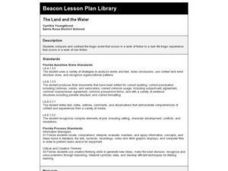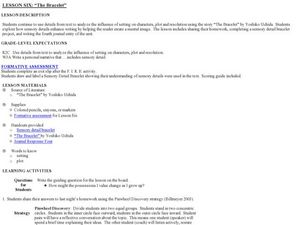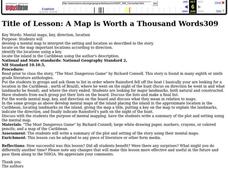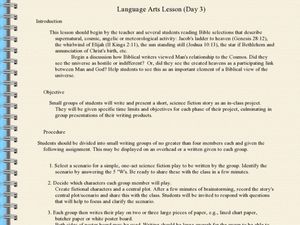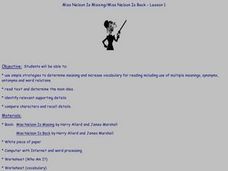Curated OER
The Land and the Water
Third graders read "The Land and the Water," a fictional short story and an article about John F. Kennedy, Jr. and compare and contrast fictional tragedy to a non-fiction tragedy. They fill out a Venn diagram and write an essay using...
Curated OER
Thank you Ma'm Langston Hughes-Devoloping the concept of Theme
Learners complete various activities linked to several stories and movies, to reinforce the concept of theme in a story.
Curated OER
The Secret Life Of Walter Mitty Lesson Plan 1
Students read the story "The Secret Life of Walter Mitty". As a class, they discuss what they daydream about and discuss why the character in the story does it. To end the lesson, they identify the characters, indirect and direct...
Curated OER
Book Club Discussion: Things Fall Apart
Students read and discuss Chinua Achebe's novel Things Fall Apart. Students are guided to analyze the text through consideration of the author's use of 6 literary devices. Students also evaluate the text according to their personal...
Curated OER
The Bracelet: Five Senses
Students investigate the 5 senses by reading children's literature. In this descriptive writing lesson, students read the story The Bracelet by Yoshiko Uchida, analyzing the story and characters as they go. Students identify the use of...
Curated OER
Dragonwings
Students engage in a activity that is concerned with the literature study of Dragonwings. They write about the story from the perspective of a reader that is well informed towards the last chapters. Students also find target vocabulary...
Curated OER
Details, Details: How Choices Reveal Character, Setting, Tone, and Theme. (Analyzing and Interpreting, Making Inferences)
Students respond to works of art. In this art interpretation lesson, students examine images of art while using concepts they learned as they read literary pieces. They detail the setting, characters, and the mood and theme of the works...
Curated OER
"Rikki-Tikki-Tavi"
Students explore nature by reading stories in class. In this animal characteristics activity, students read the story "Rikki-Tikki-Tavi," by Rudyard Kipling and identify the different animals mentioned in the book. Students review the...
Curated OER
A Map is Worth a Thousand Words
Students read the story, "The Most Dangerous Game," by Richard Connell. They discuss specific parts of the story with a group and put their lists on the board. They write a summary of the plot and setting of the story.
Curated OER
Ending At Owl Creek
High schoolers engage in a reading of "An Occurrence At Owl Creek" in order to work on the reading comprehension skills of prediction with looking at the ending. They predict the next events leading to the ending and summarize how it...
Curated OER
The Workers
Students observe the axis of a graph on the board and add the title and axis labels. They plot two points on the graph and join the two with a line and work to describe the story in each of the graphs.
Curated OER
Charlotte's Web Venn Diagram
Students, together as a class, construct a Venn diagram of characteristics they see in two classmates. Then, they independently create another Venn diagram comparing/contrasting two characters from the story Charlotte's Web. They share...
Curated OER
Introduce Vocabulary: Tar Beach
Students explore language arts by reading a children's book in class. In this story vocabulary lesson, students read the book Tar Beach and discuss the setting and plot with their classmates. Students define a list of vocabulary terms...
Curated OER
Bible Readings: Supernatural, Cosmic, Angelic, Meteorological
Young scholars create and present a short science fiction story. In this Bible studies lesson students work in small groups and are assigned characters and a scenario to develop a play about.
Curated OER
Suspense-Around
Pupils participate in round-robin cooperative writing groups to develop a variety of possible stories around a single prompt.
Curated OER
LOU GEHRIG: THE IRON HORSE
Sixth graders review with the teacher from what person the story is written in and how they have reached that conclusion. They brainstorm ten qualities that Gehrig possessed and create a statement that describes him; giving three...
Curated OER
The Hunt for Red October
Ninth graders identify and apply some of the vocabulary used in Science concerning the Sea Perch project. They view a video of The Hunt for Red October, and students make a comparative study of the translation of the printed work onto...
Curated OER
Miss Nelson is Missing/Miss Nelson is Back
Students use simple strategies to determine the meaning of a story and to increase their vocabulary. Students understand the use of multiple meaning words, synonyms, and antonyms. Students determine the main idea and identify relevant...
Curated OER
Conflict
Students outline the action in their narrative writing assignments by brainstorming about conflict. In this conflict analysis instructional activity, students define conflict and discuss the different types of conflict. Students...
Curated OER
Developing Reading Comprehension
Developing reading comprehension is an ongoing process that begins the moment a child becomes engaged with literature. From learning the skills to navigate a picture book to reading an assigned chapter in a chemistry text, good...
Mary Pope Osborne, Classroom Adventures Program
Civil War on Sunday
Reading Mary Pope Osborne's Civil War on Sunday? Here's a packet crammed with activities, exercises, reading guides, and project suggestions. A must-have for your curriculum library.
David Elementary
Structural Elements of Drama
The world may indeed be a stage, and players certainly need to know drama vocabulary. This list of 16 terms (and their definitions) often found in scripts will prompt actors to perform their role.
Shakespeare Globe Trust
Fact Sheet: Writing Plays
Who were some of the popular playwrights of Elizabethan England? Using the provided fact sheets, scholars research playwrights, explore three different types of plays, and learn about censorship in Elizabethan England.
Curated OER
What is a Fable?
Students read a variety of electronic Aesop's fables to define fable and moral, and write and illustrate an original fable. They then publish their fable using PowerPoint.


